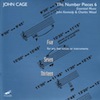 This is one of the latest in Mode Records long-running and expansive John Cage series and is one of a myriad of releases that are coinciding with his 100th birthday. The three pieces are all from the same late period in Cage’s composing career (indeed Thirteen is his last ever composition) and reflect an artist that was continuing to challenge himself, the musicians he worked with and listeners with new ideas on music and listening. The ensemble Essential Music took up this challenge and have created a stunning set of interpretations of these underrated pieces.
This is one of the latest in Mode Records long-running and expansive John Cage series and is one of a myriad of releases that are coinciding with his 100th birthday. The three pieces are all from the same late period in Cage’s composing career (indeed Thirteen is his last ever composition) and reflect an artist that was continuing to challenge himself, the musicians he worked with and listeners with new ideas on music and listening. The ensemble Essential Music took up this challenge and have created a stunning set of interpretations of these underrated pieces.
 
For the uninitiated, the Number Pieces all follow a general formula; in brief, an ensemble whose size matches the number in the title of the piece follows the brief but quite prescriptive (for Cage anyway!) instructions which usually entail the use of exact times down to at least the second. Most, if not all, the renditions of these Number Pieces end up sounding very similar but Essential Music do their best to create innovative and exciting versions of the works (probably because these recordings are all from 1994, not long after all these pieces were composed). For example, Five allows the performer to use any instrument so Essential Music look outside their usual armory of gear to the humble glass bottle. Although the idea was initially met with skepticism by Cage, it turns out that the group’s decision to perform Five by blowing into bottles that corresponded to the particular pitches specified in the score turned out to be a simple but highly effective idea. The distinctive tonal palette of glass bottles gives this particular rendition a unique sound (something close to alien flutes) and the sense of play that is appropriate to Cage’s work in general.
Picking up their regular instruments, Essential Music follow the more traditional route for the remaining two pieces. For both Seven and Thirteen, Cage specifies the type of instrumentation that would be fairly common in smaller ensembles along with varying emphasis on what each instrument is allowed to do. In Seven, the woodwind and percussion are very restricted whereas the strings and piano are given more freedom so Essential Music have created a staid, beautiful piece where the strings move in and out of consonance with each other and the piano.
The final piece, Thirteen, takes up the bulk of the disc at 30 minutes. Here, Cage’s directions state that long notes must be played quietly but short notes can be of any dynamic. As expected, a low, quiet hum creates the foundation of the piece as louder, almost hysterical, stabs of strings, piano and percussion leap out like electric shocks. The piece drifts into the kind of places György Ligeti might venture, though probably not by design (I wonder if Essential Music had been working on any Ligeti at the time as the influence is quite strong in places). What is truly striking here is that this is music that is governed mostly by a stopwatch but feels to ebb and flow entirely naturally, as if plucked from the ether.
While these pieces are deceptively simple in their instructions, even if generally quite specific for Cage, they do highlight the shortcuts in thinking that can happen when a musician is faced with such scores. Essential Music manage to perform with the spirit in which Cage intended and in the case of Five, in a way which he had not. This is a good example of what I believe Cage always wanted to achieve, a way to foster creativity without sacrificing the discipline of the performing artist.
samples:
 
Read More

